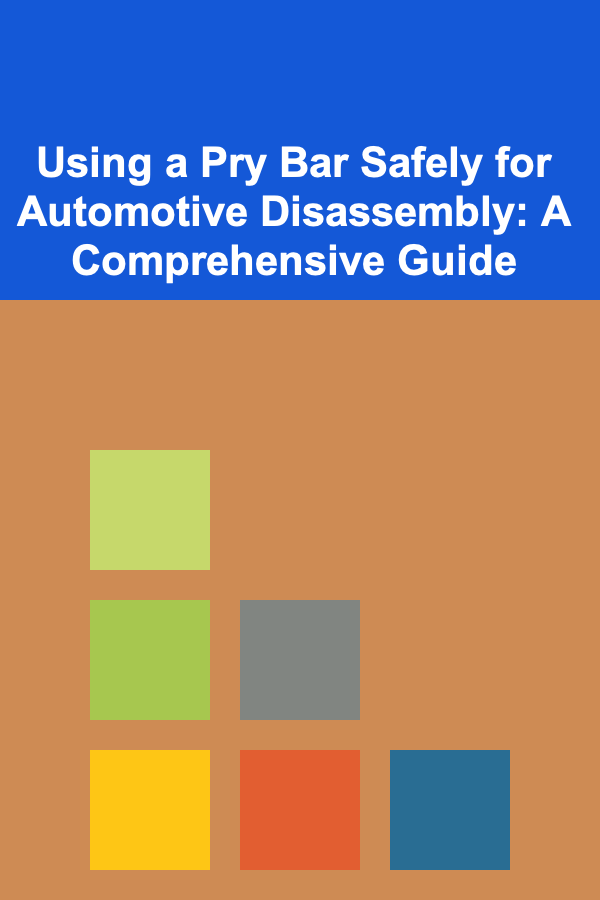
Using a Pry Bar Safely for Automotive Disassembly: A Comprehensive Guide
ebook include PDF & Audio bundle (Micro Guide)
$12.99$9.99
Limited Time Offer! Order within the next:

The pry bar, also known as a crowbar, wrecking bar, or jimmy bar, is an indispensable tool in the automotive disassembly process. It provides the leverage needed to separate stuck components, remove stubborn fasteners, and gently persuade parts that have become fused together over time due to corrosion, heat, or mechanical locking. However, its inherent power also makes it a potentially dangerous tool if used improperly. This comprehensive guide will delve into the safe and effective use of pry bars for automotive disassembly, covering everything from choosing the right bar to mastering techniques and understanding potential hazards.
Understanding Pry Bars: Types and Characteristics
Not all pry bars are created equal. Selecting the appropriate pry bar for the task at hand is crucial for both efficiency and safety. Here's a breakdown of common types:
- Standard Pry Bars: These are the most common type, typically constructed from hardened steel with a flattened, angled end (the "blade") and a handle. They come in various lengths, ranging from small pocket-sized bars to larger bars several feet long. The length of the bar dictates the leverage it can provide. Shorter bars are better for tight spaces and delicate work, while longer bars are needed for heavy-duty applications.
- Rolling Head Pry Bars: These bars feature a pivoting head on one end, allowing the blade to maintain constant contact with the work surface even when the handle is moved. This is particularly useful for aligning components or applying pressure in awkward angles. The rolling head minimizes the risk of the blade slipping or marring the surrounding surfaces.
- Gooseneck Pry Bars: Characterized by a curved or angled neck, gooseneck pry bars are designed for accessing hard-to-reach areas. The offset allows the blade to be positioned around obstructions, such as exhaust manifolds or suspension components. They are especially helpful when a straight pry bar would be impossible to use.
- Indexing Pry Bars: These offer multiple blade angles. The head of the bar can be rotated and locked into different positions, providing increased versatility and adaptability. They are useful for tasks that require frequent changes in the angle of attack.
- Specialty Pry Bars: This category includes pry bars designed for specific automotive tasks, such as separating ball joints, tie rod ends, or removing wheel bearings. These bars often have specialized blade shapes or integrated features that improve their effectiveness for these particular applications.
Beyond the type, consider these characteristics when choosing a pry bar:
- Material: High-quality pry bars are made from hardened and tempered steel. This ensures strength, durability, and resistance to bending or breaking. Look for bars that are clearly marked as being made from high-strength steel.
- Length: As mentioned earlier, the length of the bar dictates the leverage. A longer bar provides more leverage but can be cumbersome in tight spaces. Choose a length that is appropriate for the task and the available space.
- Blade Angle: The angle of the blade affects its ability to penetrate tight spaces and apply force effectively. A sharper angle is better for prying apart tightly joined components, while a shallower angle is better for spreading force over a larger area.
- Handle: The handle should be comfortable to grip and provide good control. Many pry bars have rubber or plastic grips that improve comfort and prevent slippage. Ensure the handle is securely attached to the bar.
Essential Safety Precautions Before You Pry
Safety is paramount when using any tool, and pry bars are no exception. Before you even pick up a pry bar, take the following precautions:
- Wear Appropriate Personal Protective Equipment (PPE): Always wear safety glasses or a face shield to protect your eyes from flying debris. Gloves will protect your hands from cuts and abrasions. Sturdy work boots with steel toes are recommended to protect your feet from dropped objects.
- Assess the Situation: Before you start prying, carefully examine the components you're working on. Identify any potential hazards, such as sharp edges, loose parts, or electrical wiring. Determine the best point of application for the pry bar and plan your movements.
- Secure the Vehicle: Ensure the vehicle is properly supported on jack stands before working underneath it. Never rely solely on a jack to support the vehicle's weight. Block the wheels to prevent rolling. Disconnect the negative battery cable to prevent accidental electrical shocks.
- Clear the Work Area: Keep the work area clean and free of clutter. Remove any tools, parts, or other objects that could create a tripping hazard or interfere with your movements.
- Use the Right Tool for the Job: Don't try to force a pry bar to do something it's not designed for. If you need to loosen a fastener, use a wrench or socket. If you need to cut something, use a saw or cutting tool. Using the wrong tool can damage the components and increase the risk of injury.
- Inspect Your Pry Bar: Before each use, inspect the pry bar for any signs of damage, such as cracks, bends, or chips. A damaged pry bar can break under stress, causing injury. Discard any damaged pry bars.
Mastering Pry Bar Techniques for Automotive Disassembly
Using a pry bar effectively involves more than just applying force. Here are some key techniques to master:
- Finding the Right Leverage Point: The key to successful prying is finding the point that provides the most leverage with the least amount of force. Look for areas where the pry bar can be positioned close to the joint or fastener you're trying to separate. Avoid prying against weak or fragile components that could be damaged.
- Applying Gradual Pressure: Don't try to force things apart with brute force. Apply pressure gradually and steadily, allowing the pry bar to do its work. Sudden, jerky movements can damage components or cause the pry bar to slip.
- Using a Fulcrum: A fulcrum is a fixed point against which the pry bar pivots. Using a fulcrum increases the leverage and reduces the amount of force required. Suitable fulcrums include blocks of wood, metal pipes, or other sturdy objects. Make sure the fulcrum is stable and secure before applying pressure. Avoid using fragile or unstable objects as fulcrums.
- Wiggling and Rocking: Instead of applying constant pressure, try wiggling and rocking the pry bar back and forth. This can help to loosen stuck components by breaking the bond between them. Be careful not to overdo it, as excessive wiggling can damage the components.
- Using Penetrating Oil: Penetrating oil can help to loosen corroded or seized components, making them easier to pry apart. Apply penetrating oil to the joint or fastener and allow it to soak for several minutes before attempting to pry.
- Knowing When to Stop: If you're encountering excessive resistance, don't force it. You could damage the components or injure yourself. Reassess the situation and try a different approach. Consider using heat, penetrating oil, or a different tool to loosen the components.
- Protecting Surrounding Components: Pry bars can easily scratch or damage surrounding components if you're not careful. Use shims or protective pads to protect delicate surfaces. Avoid prying against painted surfaces or polished metal.
Specific Disassembly Applications and Best Practices
Here are some common automotive disassembly applications where pry bars are frequently used, along with specific tips and best practices:
Separating Ball Joints and Tie Rod Ends
Ball joints and tie rod ends are often held in place by tapered studs that are pressed into the steering knuckle or control arm. Separating these components can be challenging, especially if they are corroded or seized.
- Use a Ball Joint Separator (Pickle Fork): While not technically a pry bar in the traditional sense, a ball joint separator (often called a pickle fork) is a specialized tool designed for this task. Wedge the fork between the ball joint and the steering knuckle, and then strike the fork with a hammer to dislodge the ball joint. Be careful not to damage the rubber boot on the ball joint.
- Pry Bar and Hammer Method (Use with Extreme Caution): If a pickle fork isn't available, you can try using a pry bar in conjunction with a hammer. Position the pry bar between the ball joint and the steering knuckle, applying gentle pressure. Then, strike the side of the steering knuckle with a hammer to shock the ball joint loose. This method carries a higher risk of damaging the ball joint or surrounding components and should only be attempted as a last resort. Wear safety glasses and gloves. Avoid hitting the ball joint stud directly.
- Protect the Boots: Be extremely careful not to damage the rubber boots on the ball joints or tie rod ends. A damaged boot will allow dirt and moisture to enter the joint, leading to premature failure. Consider using a boot protector or wrapping the boot with tape before attempting to separate the joint.
Removing Wheel Bearings
Wheel bearings are often pressed into the hub or spindle, and removing them can require significant force. Pry bars can be helpful for pushing out the bearing after it has been partially removed with a bearing press or other specialized tool.
- Use a Bearing Press (Recommended): A bearing press is the safest and most effective way to remove wheel bearings. Position the hub or spindle in the press and use the appropriate adapters to push the bearing out.
- Pry Bar and Hammer (Use as Assistive Tool): After the bearing has been partially removed using a press, or if a press is not available (use with great caution), a pry bar can be used to gently push the bearing the rest of the way out. Position the pry bar against the inner or outer race of the bearing and apply steady pressure. Avoid prying against the hub or spindle, as this could damage them. Use a hammer to gently tap the pry bar if needed.
- Heat (Use with Caution): Applying heat to the hub or spindle can help to loosen the bearing. Use a propane torch or heat gun to heat the metal around the bearing. Be careful not to overheat the metal, as this could damage it. Wear heat-resistant gloves and eye protection.
Separating Exhaust Manifolds
Exhaust manifolds are often bolted to the cylinder head and can become extremely difficult to remove due to heat, corrosion, and carbon buildup. Pry bars can be used to gently separate the manifold from the head after the bolts have been removed.
- Remove All Bolts: Make sure all the bolts that secure the exhaust manifold to the cylinder head have been removed. Trying to pry the manifold off with the bolts still in place can damage the manifold or the cylinder head.
- Penetrating Oil: Apply penetrating oil to the joint between the manifold and the cylinder head and allow it to soak for several minutes.
- Gentle Prying: Position the pry bar between the manifold and the cylinder head, applying gentle pressure. Work your way around the manifold, prying it loose a little at a time. Avoid prying against the cylinder head gasket surface, as this could damage it.
- Heat (Use with Caution): Applying heat to the manifold can help to loosen it. Use a propane torch or heat gun to heat the manifold around the joint. Be careful not to overheat the metal, as this could damage it. Wear heat-resistant gloves and eye protection.
Removing Trim and Interior Panels
Pry bars can also be useful for removing interior trim panels and components, such as door panels, dashboards, and consoles. However, use extreme caution to avoid damaging the plastic or other materials.
- Use a Trim Removal Tool: For most trim removal tasks, specialized trim removal tools made of plastic are preferable. These tools are designed to minimize the risk of scratching or breaking the trim.
- Protect the Surfaces: If you must use a metal pry bar, wrap the blade with tape or cloth to protect the surrounding surfaces.
- Locate the Fasteners: Before prying, identify the location of the clips or fasteners that are holding the trim panel in place. Prying in the wrong location can damage the panel or the surrounding components.
- Gentle Pressure: Apply gentle pressure to release the clips or fasteners. Avoid using excessive force, as this can break the panel.
Common Mistakes to Avoid
Even with proper technique, it's easy to make mistakes when using a pry bar. Here are some common pitfalls to avoid:
- Using Excessive Force: Forcing a pry bar can damage components and increase the risk of injury. If you're encountering excessive resistance, stop and reassess the situation.
- Prying Against Fragile Components: Prying against weak or fragile components can damage them. Choose a strong, stable point of application for the pry bar.
- Using the Wrong Tool: Using the wrong pry bar for the job can damage components or cause injury. Select a pry bar that is appropriate for the task and the available space.
- Neglecting Safety Precautions: Failing to wear appropriate PPE or neglecting other safety precautions can lead to serious injury. Always prioritize safety when using a pry bar.
- Using a Damaged Pry Bar: A damaged pry bar can break under stress, causing injury. Inspect the pry bar before each use and discard any damaged bars.
- Prying Without a Plan: Jumping into a prying task without assessing the situation first can lead to mistakes and damage. Take a moment to understand the task, identify potential hazards, and plan your movements.
Maintaining Your Pry Bars
Proper maintenance will extend the life of your pry bars and ensure they are always ready for use.
- Cleaning: Clean your pry bars after each use to remove dirt, grease, and grime. Use a wire brush or a cloth to clean the blade and handle.
- Lubrication: Apply a light coat of oil to the blade to prevent rust and corrosion.
- Storage: Store your pry bars in a dry place to prevent rust. Hang them on a wall or store them in a toolbox.
- Sharpening: If the blade becomes dull, sharpen it with a file or grinder. Be careful not to overheat the blade, as this can damage it.
Conclusion: A Powerful Tool, Used Responsibly
The pry bar is a powerful and versatile tool that is essential for automotive disassembly. By understanding the different types of pry bars, mastering proper techniques, and following safety precautions, you can use this tool safely and effectively to tackle a wide range of automotive repair tasks. Remember to always prioritize safety, use the right tool for the job, and take care of your tools to ensure they are always ready for use. With practice and patience, you can become proficient in the art of using a pry bar for automotive disassembly.

How to Market Your Bicycle Delivery Service to Local Businesses
Read More
How to Start Selling Used Goods on eBay with a Small Budget
Read More
How to Track Your Spending Habits to Avoid Financial Leaks
Read More
How to Find Adventure in the Amazon Rainforest
Read More
How to Explore Wave Energy Technologies
Read More
10 Tips for Baking with Seasonal Fruits
Read MoreOther Products

How to Market Your Bicycle Delivery Service to Local Businesses
Read More
How to Start Selling Used Goods on eBay with a Small Budget
Read More
How to Track Your Spending Habits to Avoid Financial Leaks
Read More
How to Find Adventure in the Amazon Rainforest
Read More
How to Explore Wave Energy Technologies
Read More